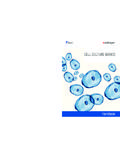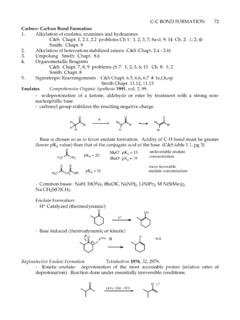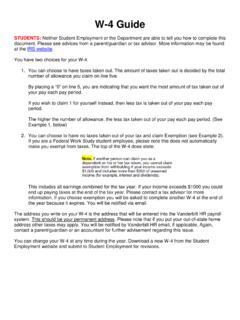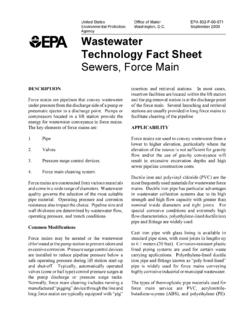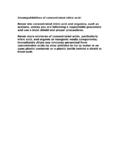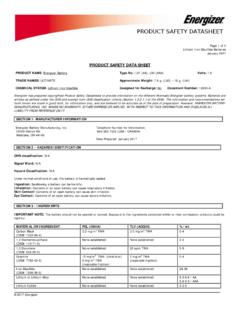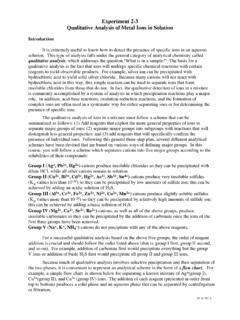Transcription of Chapter 3: Organic Compounds: Alkanes and Cycloalkanes
1 1 Chapter 3: Organic Compounds: Alkanes and Cycloalkanes >11 million Organic compounds which are classified into families according to structure and reactivityFunctional Group (FG): group of atoms which are part of a large molecule that have characteristic chemical behavior. FG s behave similarly in every molecule they are part of. The chemistry of the Organic molecule is defined by the function groups it contains 2 CCCCCCCCCCHHHHHA lkenesAlkynesArenesCCAlkanesCarbon - Carbon Multiple BondsCXX= F, Cl, Br, IAlkyl HalideCarbon-heteroatom single bondsCOCCO alcoholsethersHCNaminesCSHCCS thiolssulfides (disulfides)acidicbasicHOopsinLys-NH2 HNHLys- opsin+rhodopsinCarbon-nitrogen multiple bondsNimine(Schiff base)CCNnitrile(cyano group)basicCHOCCOC arbonyl-oxygen double bonds (carbonyls)aldehydeketonesCOOHCOOC carboxylic acidesterCClOacid chlorideCOOCO anhydridesCNOamideacidic3 Alkanes and Alkane IsomersAlkanes: Organic compounds with only C-C and C-H single (s) formula for Alkanes : CnH(2n+2)Saturated hydrocarbonsHydrocarbons: contains only carbon and hydrogenSaturated" contains only single bondsIsomers.
2 Compounds with the same chemical formula, but different arrangement of atomsConstitutional isomer: have different connectivities (not limited to Alkanes )C4H10C5H12C2H6 OOHbutanolOdiethyl etherstraight-chain or normal hydrocarbonsbranched hydrocarbonsn-butanen-pentaneSystematic Nomenclature (IUPAC System)Prefix-Parent-SuffixParent- number of carbonsPrefix- substituents Suffix- functional groups4 Naming AlkanesGeneral Formula: CnH(2n+2)suffix: -aneParent Names:1CH4 MethaneCH42CH3CH3 EthaneC2H63CH3CH2CH3 PropaneC3H84CH3(CH2)2CH3 ButaneC4H105CH3(CH2)3CH3 PentaneC5H126CH3(CH2)4CH3 HexaneC6H147CH3(CH2)5CH3 HeptaneC7H168CH3(CH2)6CH3 OctaneC8H189CH3(CH2)7CH3 NonaneC9H2010CH3(CH2)8CH3 DecaneC10H22 Alkyl substituents (group): carbon chains which are a substructue of a moleculeone carbon group off a main chainR= Rest of the molecule (mainchain)1CH3-RMethyl2CH3CH2-REthyl3CH 3CH2CH2-RPropyl4CH3(CH2)2CH2-RButyl5CH3( CH2)3CH2-RPentyl6CH3(CH2)4CH2-RHexyl7CH3 (CH2)5CH2-RHeptyl8CH3(CH2)6CH2-ROctyl9CH 3(CH2)7CH2-RNonyl10CH3(CH2)8CH2-RDecyl5 Rules for Systematic Nomenclature of the parent chain a.
3 Identify the longest continuous carbon chain as the parent chain. more than one different chains are of equal length (number of carbons), choose the one with the greater number of branch points (substituents) as the carbons = hept-CH3 CHHCCH3CH2CH2CH3CH2CH3CH3 CHCHCH3CH2CH2CH3CH2CH32 branch branch the carbons of the parent chain the carbon atoms of the parent chain so that any branch points have the lowest possible number there is branching equidistant from both ends of the parent chain, number so the second branch point has the lowest pts. at carbons 3 and 4branch pts. at carbons 4 and 54CH3 CHCH2CH2CH2 CHCHCH3CH2CH312356789H3 CCH2CH36CH3 CHCH2CH2CH2 CHCHCH3CH2CH398754321H3 CCH2CH3branch pts. at carbons 3, 6, 7branch pts. at carbons 3,4,763. Substituentsa. Identify and number the substituents and list them in alphabetical order.
4 B. If there are two substituents on the same carbon, assign them the same Write out the name a. Write out the name as a single word:hyphens (-) separate prefixescommas (,) separate numbers b. Substituents are listed in alphabetical order6CH3 CHCH2CH2CH2 CHCHCH3CH2CH398754321H3 CCH2CH3 Parent C-9 = nonane3- ethyl4-methyl7-methyl4,7-dimethyl4c. If two or more identical substituents are present use the prefixes:di- for twotri- for threetetra- for fournote: these prefixes (di-, tri-, tetra-, etc.) are not used for alphabetizing purposes6CH3 CHCH2CH2CH2 CHCHCH3CH2CH398754321H3 CCH2CH33- ethyl-4,7-dimethylnonane75. Complex Substituents (substituents with branching) a. Named by applying the four previous rules with some modification b. Number the complex substituent separately from the parent.
5 Begin numbering at the point of attachment to the parent chain. c. Complex substituents are set off by ,6-dimethyl-4-(1-methylpropyl)decaneCH2 Nonsystematic (trivial) Names:3-carbons:4-Carbons:5- Carbons:Alphabetizing trivial names: Iso- and neo are part of the alkyl group name and are used for and tert- are not included in the alphabetical (1-methylethyl)heptane-or-4-Isopropylhep tane2-methyl-6-(2-methylpropyl)decane-or -6-Isobutyl-2-methyldecaneCHH3CH3 CIsopropyl-(1-methylethyl)Parent ChainCHCH2H3 CParent Chainsec-butyl-(1-methylpropyl)Isobutyl- (2-methylpropyl)CCH3CH3tert-butyl-(1,1-d imethylethyl)H3 CCH2 Parent ChainCH3 CHH3CH3 CParent ChainCCH3CH3tert-pentyl-, tert-amyl(1,1-dimethylpropyl)CH2 Parent ChainH3 CCH2 CParent ChainH3 CCH3CH3neopentyl-(2,2-dimethylpropyl)Iso pentyl-, isoamyl(3-methylbutyl)CH2 Parent ChainCH2 CHH3CH3C8 Degrees of SubstitutionPrimary (1 ) Carbon.
6 Carbon which is bonded to only one other carbonSecondary (2 ) Carbon: carbon which is bonded to two other carbonsTertiary (3 ) Carbon: carbon which is bonded to three other carbonsQuarternary (4 ) Carbon: carbon whohc is bonded to four other carbonsHOPrimary (1 ) Secondary (2 ) Tertiary (3 )Quarternary (4 )secondaryalcohol1 Hydrogens- hydrogens on a primary carbon. -CH3 (methyl group)2 Hydrogens- hydrogens on a secondary carbon. -CH2- (methylene group)3 Hydrogens- hydrogens on a tertiary carbon. CH (methane group)H3 CCH2 CHCH3CH2 CCH3CH3CH3methyl group: 1 hydrogensmethylene group: 2 hydrogensmethine group: 3 hydrogensApplied to other functional groups:CH3CH2CH2CH2 OHn-butanol1 alcoholsCH3CH2 CHCH3 OHsec-butanol2 alcoholCH3 COHCH3CH3tert-butanol3 alcohol9 Van der Waals Forces: small temporary dipoles that are a result of a Distortion of the electron clouds.
7 There is an attraction between molecules as result of these temporary dipolesAlkanes show: regular increase in bp and mp as the molecular weight increase. Branching lowers the bp or alkanesn-pentane bp= Ci-penatane bp= Cneo-pentane bp= CParentChainPropaneCyclopropanecycloprop ylParentChainParentChainButaneCyclobutan eCyclobutylParentChainPentaneCyclopentan eHexaneCyclohexylCyclopentylCyclohexaneC ycloalkanesHeptaneParentChainCycloheptan eCycloheptylParentChainParentChainParent ChainOctaneCyclooctaneCyclooctylNonaneCy clononaneCyclononylDecaneCyclodecaneCycl odecyl10 Naming CycloalkanesGeneral Formula: CnH(2n) Chain a. Use the cycloalkane as the parent chain if it has a greater number of carbons than any alkyl If an alkyl chain off the cycloalkane has a greater number of carbons, then use the alkyl chain as the parent and the cycloalkane as a cycloalkyl- ,3-Dimethylcyclohexane-not-1,5-Dimethylc yclohexaneCH3123456CH3123456CH3CH3CH3CH3 1,2,4-Trimethylcyclohexane(1 + 2 + 4 = 7)-not-1,3,4-Trimethylcyclohexane(1 +3 + 4 = 8)2.
8 Numbering the Cycloalkanea. When numbering the carbons of a cycloalkane, start with a substituted carbon so that the substituted carbons have the lowest numbers (sum).2. b. When two or more different substituents are present, number according to alphabetical Halogen SubstituentsHalogen substituents are treated exactly like alkyl groups:-Ffluoro--Clchloro--Brbromo--Iiod o-11CO2 HchrysanthemicacidCO2 HOHOHO prostaglandin E1 HOOesteroneOOHtestosteroneOHgrandisol
